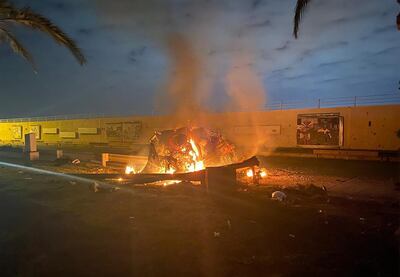US special forces troops posed as airport maintenance staff at Baghdad Airport to co-ordinate the air strike that assassinated Iran’s top commander, Qassem Suleimani, a report says.
They were joined on the ground by Kurdish special force soldiers and assisted by remote help from phone-tracking experts in Israel, it is claimed.
These leaked revelations, released in a new investigation on Saturday by Yahoo News, provide an insider account of the assassination on January 3 last year.
Three sniper teams of the US elite Delta Force disguised as airport workers waited to pinpoint the vehicle that would meet Suleimani, commander of Iran's Islamic Revolutionary Guard Corps' foreign operations arm, the Quds Force.
Suleimani was arriving on a flight from the Syrian capital Damascus.
US special forces troops were 600 to 900 metres from the “kill zone” – the access road from the airport – which was set up to triangulate the general's position as he left the airport, the report said.
It is based on interviews with 15 current and former US officials.
Members of the Counter Terrorism Group, an elite Kurdish unit in northern Iraq, posed as baggage handlers and ground crew, and helped to identify the target, it is claimed.
A member of the group is said to have guided the aircraft to a halt on the tarmac while three US drones circled overhead, armed with Hellfire air-to-ground missiles.
The CTG denied any involvement in the operation. It said Suleimani was a "close friend" of late Kurdish politician Jalal Talabani, a former president of Iraq, and that Kurdish special forces once fought on the same frontlines with Suleimani against ISIS.
Suleimani's phones
The report said one US sniper had a spotting scope with a camera attached, which streamed live back to the US embassy in Baghdad, where the Delta Ground Force commander was based with support staff.
In Tel Aviv, it is claimed, US Joint Special Operations Command liaisons worked with Israelis to help track Suleimani’s mobile phone patterns.
The Israelis, who had access to Suleimani’s numbers, passed them to the Americans, who traced his phone to Baghdad, the report said.
Members of a secretive US Army unit known as Task Force Orange were also in Baghdad that night, according to a US military official.
It provided close-range signals intelligence experts for the tactical part of the operation.
The report said that as two vehicles moved into the kill zone, two Hellfire missiles hit Suleimani’s vehicle, obliterating it.
The driver of the second vehicle tried to escape but halted within 100 metres when shot at by a Delta Force sniper.
A third Hellfire missile then destroyed that vehicle, according to the report.
Suleimani was killed along with eight others, including the deputy head of Iraq's powerful Hashed Al Shaabi paramilitary force, Abu Mahdi Al Muhandis.
The report tackled the deliberations by the administration of former president Donald Trump over killing the Iranian general and other top Iranian officials and proxies.
Quoting a CIA official, the report claims that former secretary of state Mike Pompeo said: "Don’t worry about if it’s legal; that’s a question for the lawyers."
The assassination of Suleimani followed escalation between Iran-backed Iraqi militias and coalition forces in Iraq, including a US death in December 2019.
Iran responded to the killing with a barrage of missiles on the joint Iraqi-US airbase at Al Asad in western Iraq.
Up to 100 US soldiers suffered what is known as traumatic brain injury, caused by the shockwaves of the missiles.





